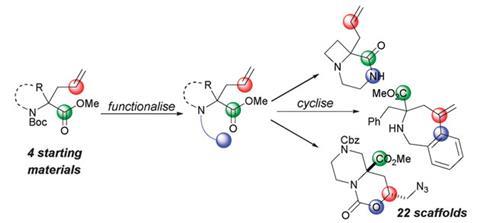Making compounds that promise to become useful drugs has just become a little easier
Researchers from the UK have developed a straightforward strategy for making compounds that have the potential to become clinical drugs. By cleverly combining robust chemistry and simple starting materials, the team accessed numerous small, diverse molecules with properties suitable for drug screening.
Even the most successful drug starts small. Pharmaceutical companies screen vast libraries of small compounds for the next lead – a molecule that interacts with a given target such as a protein or receptor. Through structural optimisation, tweaking and testing, the lead then grows into a full-fledged drug, ready for biological trials.
However, promising lead compounds often don’t make the jump to clinical drug – they’re predisposed for failure, simply because of their molecular characteristics. Drug molecules occupy a certain corner in chemical space, defined by lipophilicity, molecular weight and 3D structure, meaning there is an intrinsic link between the final drug’s and the lead’s properties. ‘One can describe the characteristics of many compounds that fail in drug development and ascribe those to certain undesirable molecular properties,’ explains Stephen Marsden, who led the University of Leeds study together with chemical biologist Adam Nelson. ‘This can be traced back very strongly to the quality of the initial lead molecules,’ says Marsden.

Marsden and his team have now shown an easy way to access lead candidates, which doesn’t require new and complex synthetic pathways to be devised. They can make 22 diverse scaffolds in an average of just three synthetic steps, from a small number of amino acid-derived building blocks and very simple known chemistry.
‘It’s a nice example of a clever strategy to make as many diverse scaffolds with the desired properties as possible,’ commends synthetic organic chemist Robert Stockman, from the University of Nottingham, UK, who was not involved in the work.
The structures and properties of Marsden’s molecules make them ideal starting points for drug discovery. ‘[Marsden’s] lead-oriented synthesis is a subset of diversity-oriented synthesis. It takes into consideration physico-chemical properties like molecular weight and lipophilicity, so that the structures are actually in the drug-like space rather than large lipophilic structures that often come out of traditional diversity-oriented synthesis,’ explains Stockman.
‘The fruits of our labour are already being tested,’ reveals Marsden. An open innovation drug discovery project called the European Lead Factory uses his compounds to create new drug screening libraries. Stockman hopes that lead-oriented synthesis will provide new antibiotics in the face of increasing bacterial resistance. ‘We’re all well aware that we’re on our last few molecules,’ he says. ‘There’s a real need for new chemical space to be screened for the next set of antibiotics. By using the simplest possible chemistry and robust well-known methodologies, industry is far more likely to use this strategy.’
References
This article is free to access until 1 July 2015. Download it here:












No comments yet